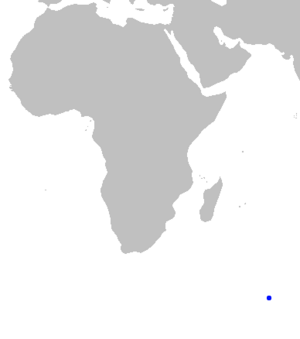Commerson's dolphin facts for kids
Quick facts for kids Commerson's dolphin |
|
|---|---|
 |
|
| A Commerson's dolphin in Chubut Province. | |
 |
|
| Size compared to an average human | |
| Conservation status | |
| Scientific classification | |
| Genus: |
Cephalorhynchus
|
| Species: |
commersonii
|
| Subspecies | |
|
|
 |
|
| C. c. commersonii distribution near South America | |
 |
|
| C. c. kerguelensis distribution near the Kerguelen Islands | |
The Commerson's dolphin (Cephalorhynchus commersonii) is a small type of oceanic dolphin. People also call it the jacobita, skunk dolphin, piebald dolphin, panda dolphin, or tonina overa. It's known for its unique black and white patterns.
This dolphin has two groups, called subspecies. They live in different parts of the world. The first group, C.c.commersonii, has very clear black and white markings. You can find them near the tip of South America. The second group, C.c.kerguelenensis, is a bit bigger. They have dark and light grey patterns, not as sharp as the first group. This group lives near the Kerguelen Islands in the Indian Ocean.
A French scientist named Dr. Philibert Commerson first described these dolphins. He saw them in 1767 in the Strait of Magellan. The dolphin is named after him.
Contents
Where do Commerson's dolphins live?
Commerson's dolphins live in two areas that are very far apart. These areas are about 8,500 km (5,300 mi) away from each other. Scientists don't know why they are spread out like this. We don't know the exact number of dolphins in the world. But we do know they are common in the places they live.
South American dolphins
The main group, C.c.commersonii, lives close to shore. You can find them in bays and inlets in Argentina. This includes places like Puerto Deseado, the Strait of Magellan, and around Tierra del Fuego. They also live near the Falkland Islands. In 1984, a study guessed there were about 3,200 dolphins in the Strait of Magellan.
Kerguelen Islands dolphins
The second group, C.c.kerguelenensis, was found in the 1950s. They live near the Kerguelen Islands. These islands are in the southern part of the Indian Ocean. These dolphins like to stay in shallow water.
In 2004, one dolphin was seen far away from its usual home. It was spotted near South Africa's Agulhas Bank. This place is 4,200 km (2,600 mi) from the Kerguelen Islands. It's 6,300 km (3,900 mi) from South America. Even though the Kerguelen Islands are closer, the dolphin would have had to swim against strong ocean currents.
What do Commerson's dolphins look like?
The South American subspecies

The commersonii subspecies has a black head, dorsal fin (the fin on its back), and fluke (its tail). Its throat and body are white. The line between the black and white colors is very clear.
This dolphin is quite small and chunky. It's one of the smallest cetaceans (a group that includes whales and dolphins). It grows to about 1.5 m (5 ft) long. The smallest adult cetacean ever recorded might be a female caught near southern Patagonia. She was 1.36 m (4.5 ft) long and weighed 23 kg (51 lb).
This dolphin looks a bit like a porpoise. But its active behavior is typical of a dolphin. Its dorsal fin has a long, straight front edge. This edge ends in a curved tip. The back edge of the fin is usually curved inward. The tail (fluke) has a notch in the middle.
It's easy to tell male and female dolphins apart. The black patch on their belly is shaped differently. In males, it looks like a teardrop. In females, it is more rounded.
Female dolphins can start having babies when they are six to nine years old. Males can also start mating around the same age. They mate in the spring and summer. After about 11 months, the babies are born, also in the spring and summer. Commerson's dolphins can live up to 18 years in the wild. One dolphin in captivity lived to be at least 33 years old.
The Kerguelen Islands subspecies
The dolphins of the kerguelenensis subspecies are usually bigger. They are different in color too. Instead of black, they are dark grey. Instead of white, they are light grey, except for their belly. The line between their dark and light colors is not as sharp as in the other subspecies.
How do Commerson's dolphins behave?
Commerson's dolphins are very active animals. You often see them swimming fast on the surface. They also leap out of the water. They spin and twist as they swim. Sometimes, they even surf on waves close to the shore.
They like to "bow-ride," which means swimming in front of fast-moving boats. They also swim upside-down sometimes. Scientists think this helps them see their food better.
These dolphins eat a mix of fish and squid. They find this food both near the coast and in the open ocean. The dolphins in South America also eat crustaceans, like crabs and shrimp. Some dolphins have been seen going into the Santa Cruz River to find food when the tide is low.
You can find them in river mouths (estuaries), especially when they are having babies.
How are Commerson's dolphins protected?
The IUCN (International Union for Conservation of Nature) lists Commerson's dolphin as "Least Concern". This means they are not currently in danger of disappearing.
However, these dolphins often swim close to shore. This means they can sometimes get caught by accident in fishing nets, like gillnets. In the 1970s and 1980s, some fishermen in Argentina and Chile used to kill these dolphins. They used them as bait for crabs. But this practice has mostly stopped now.
The Commerson's dolphin population in South America is also listed under Appendix II of the Convention on the Conservation of Migratory Species of Wild Animals (CMS). This means they would benefit from countries working together to protect them.
Can you see them in aquariums?
Yes, Commerson's dolphins have been kept and displayed in a few aquariums around the world.
See also
 In Spanish: Delfín pío para niños
In Spanish: Delfín pío para niños
- List of cetaceans


